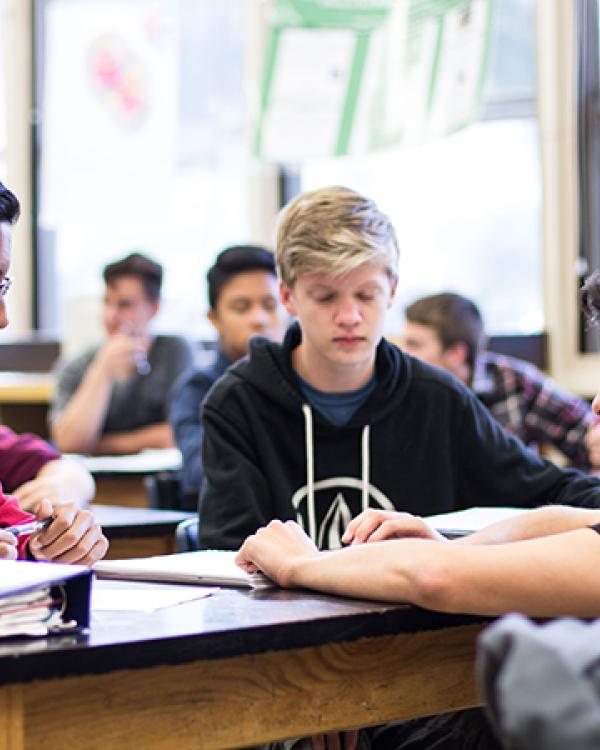
It’s the summer of 2016, and Michael Perez (M.Ed., SST/Science, ’15) is on Santa Rosa, one of the Channel Islands, assisting with research on vegetation and soil erosion. For the second year in a row, he has received a STEM Teacher and Researcher (STAR) fellowship to assist in research led by USGS scientist Kathryn McEachern (he will receive a third in 2017). “I have really grown to admire the unique biology and beauty of California's Channel Islands and the importance of ecological restoration and preservation,” Perez says. “Though I don't think I have the time to dedicate to having my own research project, I would like to volunteer to help [McEachern] collect data for her current research projects and continue visiting the Channel Islands.”
When he isn't assisting with field research, Perez teaches biology at Sato Academy of Mathematics and Science in Long Beach, CA. He has worked there since he graduated from TEP, and now heads the Science Department and is a member of the Interdisciplinary Leadership Team and School Based Decision Making board. These positions enable Perez not only to be more involved in the functioning of the school but also to foster equity and inclusivity at Sato Academy. “In each of my roles, I really try to think of equity in the classroom and how to ensure every student can be successful and feel safe on campus,” he says. “As a BIPOC and LGBTQIA person, I had educational experiences growing up where I didn't feel comfortable being myself, and I didn't see my identity reflected in the teachers I had in the classroom. I hope that by being authentic in my classroom with my students, I can be a role model for students and advocate for equity in our schools.”
TEP helped lay the foundation of Perez’s pedagogy, giving him the knowledge and perspective he needs to tailor his teaching to individual students and, by doing so, to foster the success of every student in his classroom. “One thing I loved about the M.Ed. program was the emphasis on relationships and embracing diversity,” Perez says. “As a teacher, I can adjust my practice based on observation and understanding of my students’ interests, abilities, skills, knowledge, language, family circumstances, and peer relationships.”
Perez's attention to his students’ interests and passions and his awareness of equity issues revealed a challenge. “Many [students] have not been exposed to scientists from a variety of backgrounds, which can make it difficult for them to view science as a future career for them,” he notes. For a high school teacher seeking to inspire and empower the next generation of scientists and engineers, this poses a problem. Perez’s solution? Be the scientist role-model his students need to see.
Perez conducted research as an undergraduate student at CSU Long Beach where he earned a B.S. in Biology with an emphasis on teaching, and he still had his symposium posters, so he started by hanging them up on his classroom walls. “I refer to them at various points in the year, and some students take the time to read them and ask me questions about what I did during the research projects,” he explains. Perez also has his students create posters: a critical skill for any science undergrad.
The STAR Fellowship provided the foothold Perez needed to truly round-out this approach to teaching: the program helps teachers develop lesson plans based on the research they are helping conduct. “One of my biggest takeaways from the STAR program is the benefit of bringing real data from current scientists into the classroom,” he says. “When my students interact with real data, I notice more of an interest in the applications of the data they are interpreting. By having my students engage with these types of activities instead of simply teaching about a concept where the focus is on me as the disseminator of knowledge, the activity becomes more student-centered, and the students gain the knowledge for themselves.”
Growing his student’s confidence in their own scientific abilities is just one half of the job; Perez also wants his students to see him as a scientist. “By participating in scientific research and sharing my experiences with my students, I've seen students view me as more credible in the classroom,” He says. “I always try to emphasize they are scientists in our class, and I think it helps that students see me as a scientist as well.” Perez’s experience allows him to make his lessons fun and interesting by injecting personal anecdotes, and it empowers him to direct his students to extra-curricular activities that align with their academic interests. “It's a way for students to see the things we learn about in our class have real-world applications,” he says.
Perez isn’t ready to stop pursuing his own education. Over the last two years, he has worked to become a National Board Certified Teacher. It was a rigorous and demanding process, especially when he piled it on top of his other responsibilities, but he was certified in December. “In my district, I am now considered a Master Teacher and offer my assistance to other teachers in my district who are pursuing certification,” he explains. He also has plans to attend a leadership program for his district in the spring.
Perez is going to continue assisting with research as well. The STAR program isn’t the only one that offers K-12 educators the opportunity to gain field experience from which to design lessons, and he plans to explore the options available for another fellowship. “Learning is a lifelong endeavor for every person, and I am eager to continue learning!” he asserts. Perez will continue to inspire his students with his passion for science for the rest of their lives as well as his own.